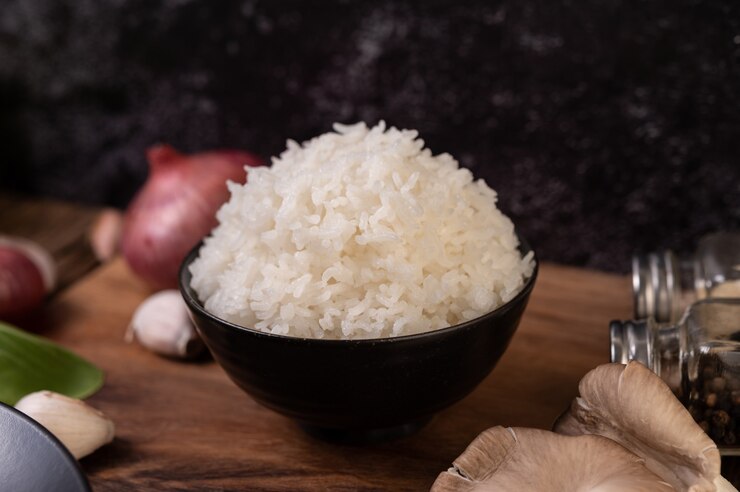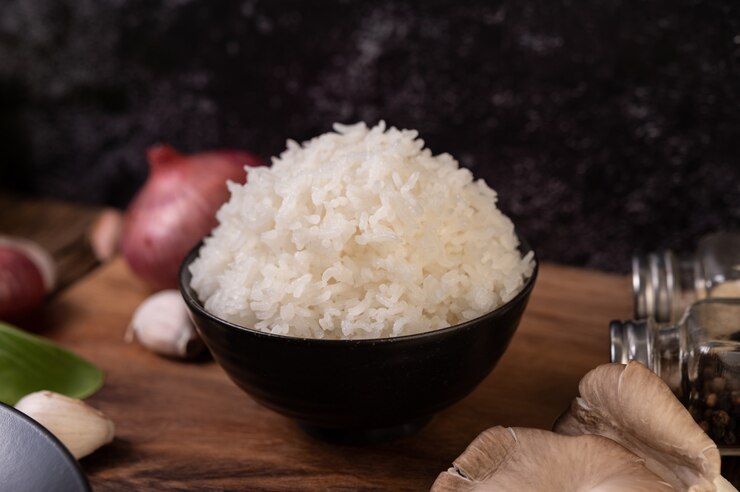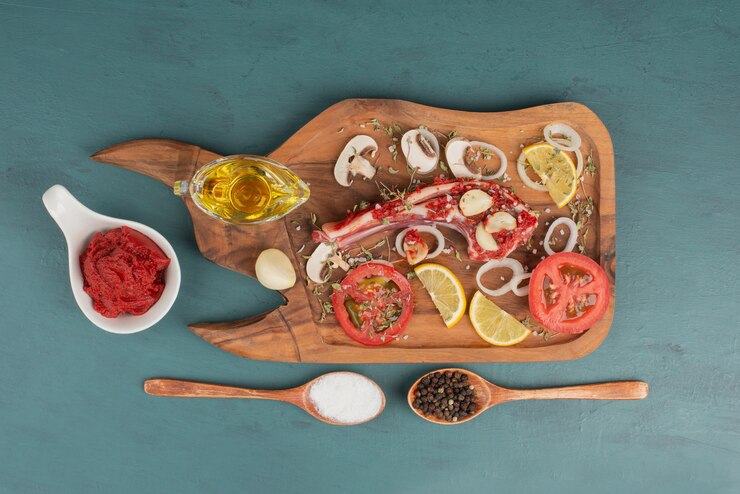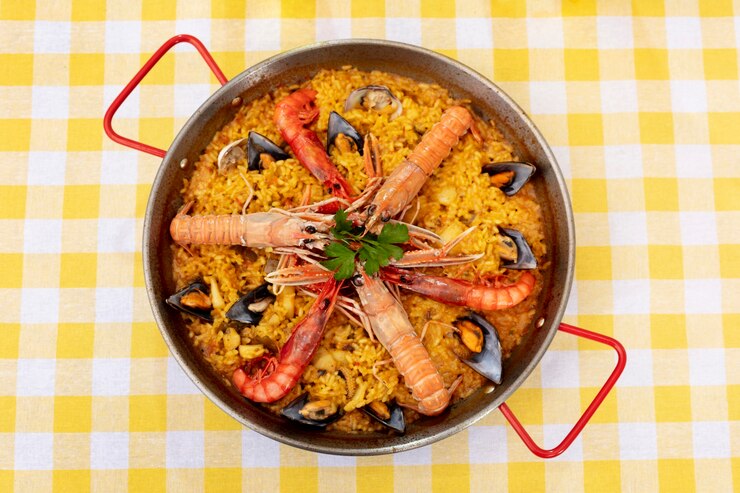Introduction of Exotic Rice Method Recipe 2024:
Exotic Rice Method Recipe: Unlocking the Flavors
Discover the tantalizing world of Exotic Rice Method Recipe 2024! In this guide, we delve into the secrets of cooking rice using unconventional methods that will elevate your culinary repertoire. From rare rice varieties to innovative cooking techniques, get ready to embark on a flavorful journey that will leave your taste buds craving for more. Let’s dive in!

Table of Contents
Exploring Exotic Rice Varieties
Rice, a staple food for billions around the globe, comes in a dazzling array of varieties, each with its own distinct flavor, texture, and cultural significance. In this section, we’ll shine a spotlight on some lesser-known exotic rice varieties that are sure to intrigue and inspire your culinary adventures.
Highlighting Lesser-Known Rice Varieties
Black Rice (Forbidden Rice):
- Originating from Asia, particularly China and Indonesia, black rice boasts a striking dark hue and a slightly sweet, nutty flavor profile. It’s rich in antioxidants and nutrients, making it both a delicious and nutritious choice.
Jasmine Rice:
- Hailing from Thailand, jasmine rice is prized for its delicate floral aroma and soft, slightly sticky texture. It pairs wonderfully with a wide range of dishes, from Thai curries to stir-fries.
Basmati Rice:
- A fragrant long-grain rice variety cultivated primarily in the Indian subcontinent, basmati rice is renowned for its distinct aroma and fluffy texture. It’s a staple in many South Asian and Middle Eastern cuisines.
Arborio Rice:
- Originating from Italy, arborio rice is commonly used in risotto due to its high starch content, which yields a creamy texture when cooked. Its plump grains absorb flavors exceptionally well, making it perfect for hearty, comforting dishes.
Bomba Rice:
- Hailing from Spain, bomba rice is the preferred choice for making paella thanks to its ability to absorb liquid while remaining firm and separate. Its short, round grains create a delectably textured dish that’s sure to impress.
Describing the Unique Flavors and Textures
- Each exotic rice variety brings its own unique characteristics to the table. Black rice offers a slightly chewy texture and a subtle nuttiness, while jasmine rice delights with its floral aroma and soft, clingy grains. Basmati rice charms with its long, slender grains and aromatic fragrance, while arborio rice beckons with its creamy texture and ability to absorb rich flavors. Bomba rice, on the other hand, delivers a toothsome bite and a satisfyingly firm texture, perfect for hearty one-pot meals like paella.
Discussing the Cultural Significance
- Beyond their culinary appeal, exotic rice varieties hold significant cultural importance in their countries of origin. For example, black rice is steeped in symbolism and often reserved for special occasions or ceremonies in Asian cultures. Jasmine rice is a cornerstone of Thai cuisine and plays a central role in cultural rituals and celebrations. Basmati rice is deeply ingrained in the culinary traditions of South Asia, where it’s revered as the “king of rice.” Arborio rice is synonymous with Italian comfort food, while bomba rice is an essential ingredient in Spain’s beloved paella dish. Understanding the cultural context behind these rice varieties adds depth and richness to the culinary experience.
Understanding Different Rice Cooking Methods
Rice, though seemingly simple, can be cooked in a myriad of ways, each method yielding distinct textures and flavors. In this section, we’ll explore the nuances of various rice cooking methods, from traditional techniques to exotic approaches, and understand how they can enhance the overall dining experience.
Overview of Traditional vs. Exotic Techniques
- Traditional rice cooking methods, such as boiling or steaming, are tried-and-true approaches that have been passed down through generations. While these methods certainly have their merits, exotic rice cooking techniques offer a fresh perspective, infusing rice dishes with creativity and innovation.
- Exotic methods might include techniques like pilaf, where rice is sautéed with aromatics before cooking, or the absorption method, where rice is cooked in a measured amount of liquid until fully absorbed, resulting in perfectly fluffy grains.
Importance of Choosing the Right Method
- Selecting the appropriate cooking method is crucial for achieving the desired texture and flavor in your rice dishes. Some rice varieties, like basmati or jasmine rice, excel when cooked using the absorption method, as it allows them to absorb just the right amount of liquid while remaining fluffy and separate.
- Other varieties, such as arborio or bomba rice, are best suited for techniques like risotto or paella, where the starchiness of the rice is prized for creating a creamy, indulgent texture.
Highlighting Key Differences in Preparation and Cooking Times
- Preparation and cooking times can vary significantly depending on the chosen rice cooking method. For example, the absorption method typically requires a longer cooking time compared to boiling, as the rice slowly absorbs the liquid while cooking.
- Additionally, certain methods, like pilaf or risotto, may involve additional steps such as sautéing aromatics or gradually adding liquid to the rice, which can influence both the flavor and texture of the final dish.
By understanding the intricacies of different rice cooking methods, you can elevate your culinary skills and create rice dishes that are as diverse and flavorful as they are satisfying.
IV. Exotic Rice Recipes
In this section, we’ll dive into the heart of exotic rice cooking by exploring two tantalizing recipes that showcase the versatility and flavor potential of exotic rice varieties.
Recipe 1: Fragrant Coconut Jasmine Rice
Ingredients:
- 1 cup jasmine rice
- 1 cup coconut milk
- 1 cup water
- 1 tablespoon coconut oil
- 1 teaspoon salt
- Optional: shredded coconut for garnish

Instructions:
a. Rinse the jasmine rice under cold water until the water runs clear, then drain. b. In a medium saucepan, combine the rinsed rice, coconut milk, water, coconut oil, and salt. c. Bring the mixture to a boil over medium heat, then reduce the heat to low, cover, and simmer for 15-20 minutes, or until the liquid is absorbed and the rice is tender. d. Remove the saucepan from the heat and let the rice sit, covered, for an additional 5 minutes to steam. e. Fluff the rice with a fork and transfer to a serving dish. Garnish with shredded coconut, if desired, and serve hot.
Tips for Enhancing Flavor and Texture:
- For an extra burst of flavor, toast the coconut flakes before garnishing the rice.
- You can also add a squeeze of lime juice or a sprinkle of fresh cilantro for a bright, herbaceous twist.

Recipe 2: Spanish Seafood Paella
Ingredients:
- 1 cup bomba rice
- 2 cups chicken or seafood broth
- 1 onion, finely chopped
- 2 cloves garlic, minced
- 1 red bell pepper, diced
- 1 tomato, diced
- 1/2 teaspoon saffron threads
- 1/2 teaspoon smoked paprika
- 1/2 pound shrimp, peeled and deveined
- 1/2 pound mussels, cleaned and debearded
- 1/2 cup frozen peas
- Salt and pepper to taste
- Olive oil for cooking

Instructions of Spanish Seafood Paella:
a. In a paella pan or large skillet, heat olive oil over medium heat. Add the onion, garlic, and bell pepper, and sauté until softened, about 5 minutes. b. Stir in the diced tomato, saffron threads, and smoked paprika, and cook for another 2-3 minutes. c. Add the bomba rice to the pan and stir to coat it with the vegetable mixture. d. Pour the chicken or seafood broth into the pan and bring to a simmer. Reduce the heat to low and cook, uncovered, for about 15 minutes, or until most of the liquid is absorbed and the rice is tender. e. Nestle the shrimp, mussels, and frozen peas into the rice, cover, and cook for an additional 5-7 minutes, or until the seafood is cooked through and the mussels have opened. f. Season the paella with salt and pepper to taste, and garnish with fresh parsley before serving.

Serving Suggestions and Pairing Recommendations:
- Serve the Spanish seafood paella hot, straight from the pan, with crusty bread and a glass of chilled white wine for a complete dining experience.
- You can customize this paella recipe by adding other seafood such as calamari or clams, or incorporating your favorite vegetables for added flavor and color.
Tips for Perfecting Exotic Rice Dishes
Creating delicious and flavorful exotic rice dishes requires attention to detail and a few insider tips and tricks. In this section, we’ll explore essential tips for perfecting your exotic rice creations.

Selecting the Best Quality Rice
Know Your Rice: Familiarize yourself with the characteristics of different rice varieties to choose the best one for your dish.
Quality Matters: Opt for high-quality rice from reputable sources to ensure superior flavor and texture.
Proper Measurement and Water-to-Rice Ratio
- Use the Right Amount of Water: Follow the recommended water-to-rice ratio for each rice variety to achieve optimal results.
- Measure Accurately: Use a measuring cup to accurately measure both the rice and water for consistent results.
Adjusting Cooking Times for Different Rice Varieties
- Be Mindful of Cooking Times: Understand that cooking times may vary depending on the type of rice you’re using.
- Test for Doneness: Use a fork to test the doneness of the rice—grains should be tender but still slightly firm to the bite.
Flavoring Techniques and Ingredient Combinations
- Infuse Flavor: Experiment with different flavoring techniques such as using aromatics like garlic, onions, and spices to infuse the rice with depth and complexity.
- Get Creative with Ingredients: Don’t be afraid to get creative with ingredient combinations—incorporate herbs, citrus zest, nuts, or dried fruits to add layers of flavor and texture.
Finishing Touches and Presentation
- Fluff with Care: Use a fork to gently fluff the cooked rice to separate the grains and release excess steam.
- Garnish with Flair: Elevate the presentation of your dish by adding a final flourish—think fresh herbs, toasted nuts, or a drizzle of flavored oil.
By mastering these tips, you’ll be well on your way to creating exotic rice dishes that are bursting with flavor and sure to impress.
Serving and Presentation
The way you present and serve your exotic rice dishes can greatly enhance the dining experience, elevating them from mere meals to culinary works of art. In this section, we’ll explore creative plating ideas and garnishing tips to help you showcase your exotic rice creations with style and flair.
Creative Plating Ideas for Exotic Rice Dishes
- Molded Rice: Use a small bowl or ring mold to shape cooked rice into neat, compact servings before transferring them onto plates.
- Layered Rice: Create visually appealing layers by alternating different colored rice varieties or adding layers of flavorful ingredients like vegetables or proteins.
- Stuffed Vegetables: Hollow out bell peppers, tomatoes, or zucchinis and fill them with exotic rice pilaf or risotto for an elegant and colorful presentation.
- Rice Bowls: Serve exotic rice dishes in decorative bowls garnished with fresh herbs, sesame seeds, or thinly sliced vegetables for added texture and visual appeal.
Garnishing Tips to Elevate the Visual Appeal
- Fresh Herbs: Sprinkle chopped fresh herbs like parsley, cilantro, or chives over your rice dishes to add a pop of color and freshness.
- Citrus Zest: Grate lemon, lime, or orange zest over the rice for a burst of citrus flavor and vibrant color.
- Toasted Nuts and Seeds: Toasted almonds, cashews, or sesame seeds not only add crunch but also lend a rich, nutty flavor to your dishes.
- Drizzles and Sauces: Finish off your rice dishes with a drizzle of flavored oils, such as basil-infused olive oil or chili oil, or a swirl of tangy sauce for added complexity and visual interest.

Pairing Suggestions with Complementary Sides or Beverages
- Side Dishes: Consider serving your exotic rice dishes with complementary side dishes such as grilled vegetables, salads, or pickled condiments to balance flavors and textures.
- Beverage Pairings: Pair your rice dishes with beverages that enhance their flavors—try crisp white wines like Riesling or Sauvignon Blanc with seafood paella, or aromatic teas like jasmine tea with coconut jasmine rice for a harmonious pairing.
By paying attention to presentation and garnishing, you can transform your exotic rice dishes into stunning culinary creations that are as delightful to the eyes as they are to the palate.
Recipe 1: Fragrant Coconut Jasmine Rice (Per Serving)
| Nutrient | Amount Per Serving |
|---|---|
| Calories | 250 |
| Total Fat | 10g |
| – Saturated Fat | 8g |
| Cholesterol | 0mg |
| Sodium | 400mg |
| Total Carbohydrates | 35g |
| – Dietary Fiber | 1g |
| – Sugars | 1g |
| Protein | 3g |
Recipe 2: Spanish Seafood Paella (Per Serving)
| Nutrient | Amount Per Serving |
|---|---|
| Calories | 350 |
| Total Fat | 12g |
| – Saturated Fat | 2g |
| Cholesterol | 50mg |
| Sodium | 600mg |
| Total Carbohydrates | 45g |
| – Dietary Fiber | 2g |
| – Sugars | 2g |
| Protein | 15g |
Please note that these values are approximate and can vary based on factors such as specific ingredients used and portion sizes.
FAQs
Can I use any type of rice for these recipes?
Yes, you can adapt the recipes to suit your preferences by using different types of rice. However, for the Fragrant Coconut Jasmine Rice recipe, jasmine rice works best due to its delicate flavor and texture, while bomba rice is recommended for the Spanish Seafood Paella to achieve the traditional creamy texture.
Is coconut milk necessary for the Fragrant Coconut Jasmine Rice, or can I use water instead?
Coconut milk adds richness and flavor to the dish, but you can substitute it with water if desired. However, keep in mind that using water will result in a less fragrant and flavorful rice.
I’m allergic to seafood. Can I omit the seafood from the Spanish Seafood Paella recipe?
Absolutely! You can customize the paella recipe to suit your dietary preferences by omitting the seafood and adding more vegetables or proteins of your choice, such as chicken or tofu.
How long can I store leftovers of these rice dishes?
Both recipes can be stored in an airtight container in the refrigerator for up to 3-4 days. Reheat the leftovers in the microwave or on the stovetop until heated through before serving.
Can I freeze these rice dishes?
While it’s not recommended to freeze cooked rice dishes like paella, you can freeze cooked jasmine rice (without coconut milk) for up to 1 month. Thaw in the refrigerator overnight before reheating.
I don’t have saffron for the paella recipe. Can I omit it?
Saffron adds color and a distinctive flavor to the paella, but if you don’t have it, you can omit it or substitute with a pinch of turmeric for a similar color.
Can I make these recipes vegan-friendly?
Yes, both recipes can be made vegan-friendly by substituting chicken broth with vegetable broth and omitting or replacing animal-based ingredients like seafood or chicken with plant-based alternatives.
Is it necessary to rinse the rice before cooking?
Rinsing the rice helps remove excess starch and prevents it from becoming too sticky. It’s recommended to rinse jasmine rice for the Fragrant Coconut Jasmine Rice recipe, but you can skip this step for bomba rice in the paella recipe.
What can I serve as a side dish with these rice recipes?
For a complete meal, you can serve the Fragrant Coconut Jasmine Rice with your favorite curry or grilled meats, while the Spanish Seafood Paella pairs well with a side salad, crusty bread, or a glass of Spanish wine.
Can I double or halve the recipes?
Yes, you can easily adjust the quantities to double or halve the recipes based on your serving needs. Just be sure to adjust cooking times accordingly and taste as you go to ensure the flavors are balanced.
Conclusion of Exotic Rice Method Recipe 2024:
In conclusion, mastering the art of cooking with exotic rice varieties opens up a world of culinary possibilities, allowing you to explore diverse flavors, textures, and cultural traditions from around the globe. By understanding different rice cooking methods, experimenting with flavor combinations, and paying attention to presentation, you can create exotic rice dishes that are as visually stunning as they are delicious. Whether you’re indulging in fragrant coconut jasmine rice or savoring a hearty Spanish seafood paella, each dish tells a story and invites you on a culinary journey of discovery. So, embrace the allure of exotic rice cooking, and let your taste buds travel to distant lands with every mouthwatering bite.
Pingback: Bakers Square Candy Cane Pie Recipe 2024- 10 secrets
Pingback: Gordon Ramsay Lasagne Recipe in 2024- Top 10 Secrets
Pingback: Sherri Shepherd Show Recipes Today in 2024- top 5 secrets
Pingback: Freeze Dried Food Recipes in 2024 - Top 5 Secrets
Pingback: What is the rice hack tiktok recipe in 2024-Top 7 secrets